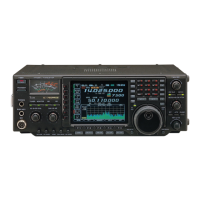3 - 7
(1) REFERENCE LOOP PLL
The oscillated signal at the reference VCO (Q151, D151) is
amplified at the buffer amplifiers (Q102, Q152) and is then
applied to the DDS IC (IC101, pin 46). The signal is then
divided and detected on phase with the DDS generated
frequency.
The detected signal output from the DDS IC (IC101, pin
56) is converted into DC voltage (lock voltage) at the loop
filter (R135–R137, C121, C151) and then fed back to the
reference VCO circuit (Q151, D151).
(2) MAIN LOOP PLL
The oscillated signal at one of the main loop VCOs (Q201,
D201, D202), (Q221, D221, D222), (Q251, D251–D254)
and (Q271, D271–D274) is amplified at the buffer amplifi-
ers (Q301, IC320) and is then applied to the PLL IC (IC381,
pin 6) via the low-pass filter (L303, C304–C307). The signal
is then divided and detected on phase with the reference
loop output frequency.
The detected signal output from the PLL IC (IC381; pin 2)
is converted into a DC voltage (lock voltage) at the loop
filter and then fed back to one of the VCO circuits (Q201,
D201, D202), (Q221, D221, D222), (Q251, D251–D254)
and (Q271, D271–D274).
The oscillated signal is amplified at the buffer amplifiers
(Q301, IC320) and then applied to the RF-B unit as a 1st
LO A signal after being passed through the low-pass filters
(L303, C304–C307 and L351–L353, C351–C356) and high-
pass filter (L354, C358–C360) and mute circuit (D361).
3-3-3 2ND LO AND REFERENCE OSCILLATOR
CIRCUITS
The reference oscillator (X52, Q51) generates a 32.0 MHz
frequency for the 4 DDS circuits as a system clock and
for the LO output. The oscillated signal is doubled at the
doubler circuit (Q71, Q81) and the 64.0 MHz frequency is
picked up at the double tuned filter (L81, L82). The 64.0
MHz signal is applied to the RF-B unit as a 2nd LO signal.
3-3-4 3RD LO CIRCUIT
The DDS IC (IC701) generates a 10-bit digital signal using
the 32 MHz system clock. The digital signal is converted
into an analog wave signal at the D/A converter (R701–
R720). The converted analog wave is passed through the
bandpass filter (L702, L703, C709–C713) and then applied
to the MAIN-A unit as the 3rd LO signal.
3-3-5 MARKER CIRCUIT
The divided signal at the DDS circuit (IC101) is used for
the marker signals with the IC-756PROIII.
The reference signal for the DDS circuit (32.0 MHz) is
divided to produce an acceptable frequency signal, 16
MHz, with the programmable divider then divided again by
160 to obtain 100 kHz cycle square-wave signals.
The generated marker signals are output from pin 66 of the
DDS IC (IC101), and are then applied to the RF-B unit via
the mute switch (IC192) and J851 as the MKR signal.
• PLL CIRCUIT
64.485–
124.455 MHz
0.03–
60.0 MHz
455 kHz
36 kHz
10.747–
10.865 MHz
64.485–
124.455 MHz
64.0 MHz
77.8 MHz
ANT
1st mixer A
Q1203–Q1206
491 kHz
to scope circuit
(RF-B unit, D2101)
to scope circuit
(RF-B unit, IC2001)
IC801IC701
IC101
IC381
IC901
Q71
Q81
Q902
S2LOS3LO
3LO
X2
2LO
1LOB
1LOA
77.8 MHz
RF-B unit
PLL unit
MAIN-A unit
Q201
Q221
Q251
Q271
Q151
1st LO PLL A
circuit
Phase
detector
1/N divider
1/22
Phase
detector
12 bit
D/A
Main loop PLL
Ref. loop PLL
DDS
1st mixer B
1st LO
PLL B
circuit
DDS
D/A
DDS
D/A
PLL
IC
Crystal
filter
2nd mixer
D1752
3rd mixer
IC151
FI1701
64.455 MHz
to DSP-A board
Reference oscillator
X52: 32.0 MHz
BPFBPF
Loop
filter
LPF
LPF

